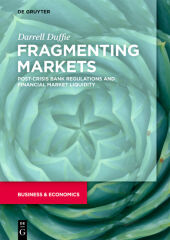 Neuerscheinungen 2020Stand: 2020-02-01 |
Schnellsuche
ISBN/Stichwort/Autor
|
Herderstraße 10
10625 Berlin
Tel.: 030 315 714 16
Fax 030 315 714 14
info@buchspektrum.de |

Darrell Duffie
Post-Crisis Bank Regulations and Financial Market Liquidity
2020. 120 S. 25 b/w ill., 40 b/w tbl. 240 mm
Verlag/Jahr: DE GRUYTER 2020
ISBN: 3-11-067302-9 (3110673029)
Neue ISBN: 978-3-11-067302-9 (9783110673029)
Preis und Lieferzeit: Bitte klicken
Post-crisis capital regulations and new failure-resolution rules increase the funding costs that are borne by bank shareholders, and thus the cost to buy-side firms for access to space on the balance sheets of large banks. A policy implication is the encouragement of market infrastructure and trading methods that reduce the amount of space on bank balance sheets that is needed to conduct a given amount of trade.
Using models and evidence, this book addresses the implications for financial-market liquidity of these regulations for systemically important banks and argues that current rules do not allow for potential levels of market efficiency and financial stability. In this insightful analysis of the impact of regulation on financial market efficiency post-2008, the author argues that bank capital levels could actually be pushed higher while still improving the liquidity of markets for safe assets such as low-risk fixed-income instruments by relaxing the leverage-ratio rule and increasing risk-based capital requirements.
1 The Cost of Bank Balance Sheet Space 14
1.1 The setting 15
1.2 Debt overhang has risen 18
1.3 Liquidity provision by dealers 25
1.4 Modigliani-Miller and asset substitution 27
1.5 Impact on swap markets 29
1.6 Strategic implications for dealers 31
1.7 Asset pricing implications 33
1.8 The leverage-ratio rule 34
1.9 European versus U.S. banks 35
1.10 Competition and price transparency 37
1.11 The efficient stability-liquidity frontier 38
2 Leverage Rule Distortions 42
2.1 Leverage rule distortions 42
2.2 Repo intermediation under the SLR 46
2.3 SLR degrades monetary-policy passthrough 55
3 Dealer Funding Costs 59
3.1 An illustrative example: T-bill investment 60
3.2 Post-crisis increases in dealer funding costs 61
3.3 A model of dealer funding costs 64
3.4 CIP arbitrage could harm shareholders 67
3.5 Regulatory capital and the CIP basis 71
4 Market Design Implications 74
4.1 Opaque bilateral trade is inefficient 75
4.2 Multilateral trade 77
4.3 Size discovery 79
4.4 Mandating multilateral trade facilities 82
4.5 Post-trade price transparency 86
4.6 Market infrastructure 90
4.7 Compression trading 93
Bibliography 95
Darrell Duffie, Dean Witter Distinguished Professor of Finance, Graduate School of Business, Stanford University, USA


